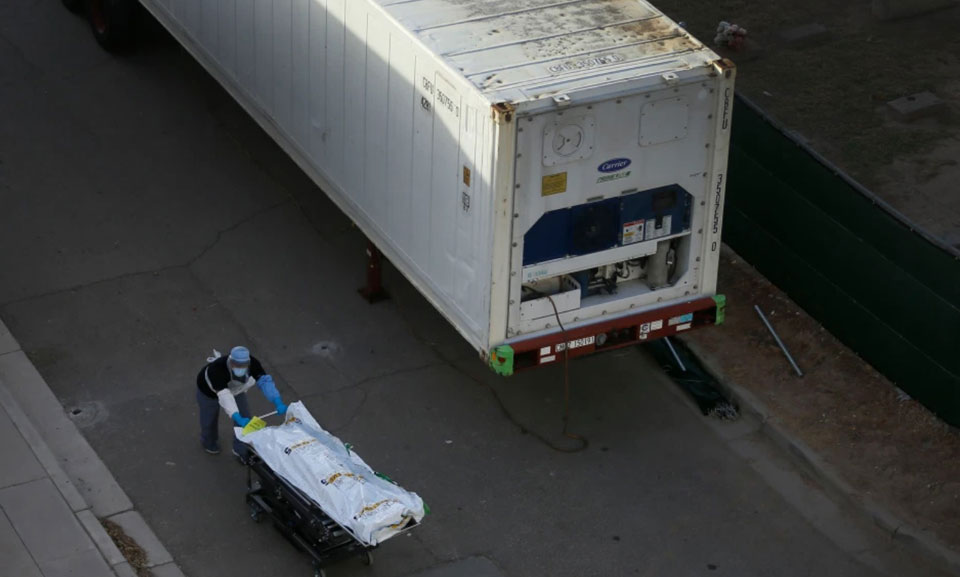
EL PASO, Texas—The county jail was using incarcerated labor to move the corpses of COVID-19 patients into mobile morgues in El Paso, Texas last fall. Media coverage focused on inmates “helping” and “volunteering,” even as they were being paid only $2 per hour.
Incarcerated people at Airway Heights Correction Center in Washington state are being coerced into making food for just 90 cents to $1.70 per hour, even as over 40% of the prison population tested positive for COVID-19. Choosing to “volunteer” within a prison, often with zero financial resources at one’s disposal, is not really a free choice. Incarcerated people do not have the agency behind bars to make such autonomous choices.
The largest corporate news outlets covering this story have been The Guardian, CNN, and ABC News, the latter only mentioning it in passing. Major publications like the New York Times and Washington Post have not extensively reported on these stories, nor on many other cases of labor exploitation during the pandemic.
As the COVID-19 pandemic rages on, journalism is failing to reach incarcerated people. The virus is rapidly infecting and killing this most vulnerable population, with one in five incarcerated people having tested positive for the disease and over 2,000 dead. Yet media coverage has not sufficiently represented or empowered their struggle for survival.
Neglected and kept ignorant
Trapped in cages and cut off from the world, incarcerated people are largely unable to access any news of the pandemic despite the impact of the virus on their lives. Although major outlets have covered the spread of the virus inside prison walls, the reporting on the struggles of incarcerated people and advocates — from hunger strikes to movements for decarceration — has been scanty.
“Prisoners still don’t have access to the internet,” Ry, an inmate at a Pennsylvania state correctional institution said in written correspondence to People’s World. Without the internet, incarcerated people are left in the dark on the state of the pandemic and its spread within prisons.
Robert Castile, who is incarcerated at Lawrence Correctional Facility in Illinois said through written correspondence to People’s World, “I’m experiencing it firsthand and seeing the injustices. Down here, for instance, they have inmates working seven days a week and they aren’t paying them for all seven days.”
Labor exploitation has always been a structural problem within prisons, long before the pandemic. Incarcerated people can be paid anywhere from nothing at all to perhaps a few cents on the dollar, but never more than a maximum of $5 per hour.
Another aspect of the COVID experience inside prison walls has been the explosion in the use of solitary confinement, up 500% over the course of the pandemic, according to the group Solitary Watch. This form of torture has also been used to silence incarcerated people who protested their dangerous living conditions. Confining incarcerated people to their cells with no human interaction or chance for fresh air is becoming more and more common a solution to the pandemic, leaving incarcerated people to suffer the severe psychological consequences while supposedly protecting them from the virus.
The psychological impact of the pandemic and forced isolation on people who already spend most of their time in a cage is also widely underreported. When the mental health consequences of the pandemic for the general population are reported on by major media outlets, incarcerated people are routinely excluded from the coverage. Only one story from a major news outlet on this practice was found over the course of extensive research. Movements among incarcerated people and their advocates have also received negligible coverage from mainstream outlets. Movements for decarceration, prison abolition, and safe conditions inside and outside prison walls have been ongoing for months, yet the general public is largely unaware due to the lack of reporting. Chicago Tribune is the only major paper to report on any of the several hunger strikes by incarcerated people.
Outside of prison walls, advocates have been organizing for decarceration since the pandemic began, noting the extreme public health hazard posed by prisons and jails. Campaigns like Free Them All for Public Health and Release Aging People in Prison are only mentioned in passing, if at all, despite the months of organizing during the pandemic that have driven these efforts.
It falls to independent media to empower the voices of incarcerated people as the pandemic grows more deadly in prisons by the day. Independent, working-class publications like People’s World has challenged corporate media’s pattern of neglect. People’s World sends out weekly newsletters to almost 70 incarcerated individuals across the country, covering issues of utmost importance to them. People’s World has also collected feedback from its incarcerated readers in order to maximize the newsletter’s effectiveness and cover the issues that matter.
More extensive reporting that actually reaches incarcerated people — through newsletters or campaigns for internet access, for example — is essential to end the pattern of neglect on the part of the corporate press. Journalism that amplifies decarceration efforts is also needed now more than ever as overpopulated, disease-ridden prisons kill incarcerated people.
The media ought to do better in challenging the dominant narratives around incarceration and the prison industrial complex that minimize the grave reality.












Comments